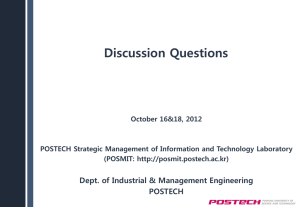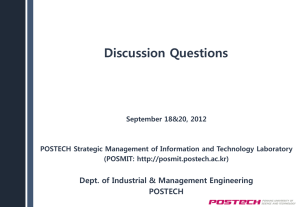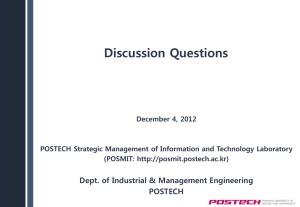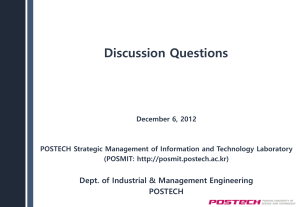06.Samsung SDS
advertisement
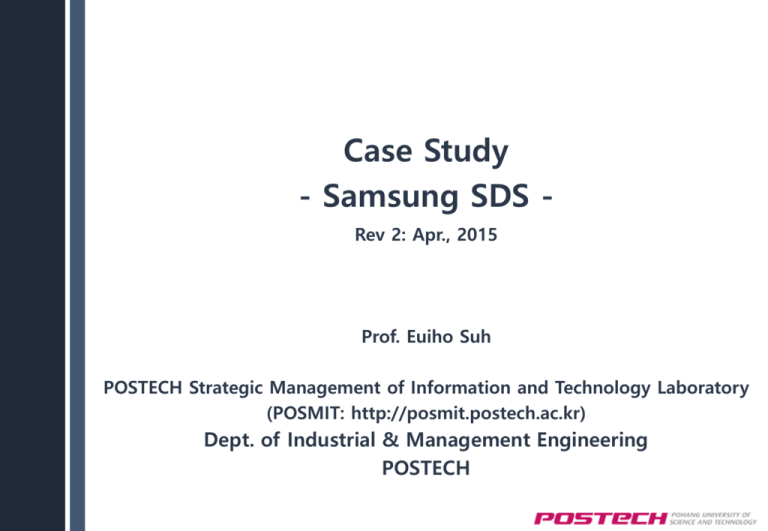
Case Study - Samsung SDS Rev 2: Apr., 2015 Prof. Euiho Suh POSTECH Strategic Management of Information and Technology Laboratory (POSMIT: http://posmit.postech.ac.kr) Dept. of Industrial & Management Engineering POSTECH Contents 1 Introduction 2 Vision & Mission in 2005 - Overview 3 Vision in 2005 4 Mission in 2005 5 Goals in 2005 6 SWOT Analysis 7 BCG Matrix 8 GE/Mckinsey Matrix 9 International and Domestic Strategies Introduction Overview Business areas Established in 1985 The biggest System Integration (SI) company in Korea Intelligent manufacturing Intelligent logistics Intelligent office Intelligent surveillance Smart education Smart healthcare Smart converged space 3 Vision & Mission in 2005 - Overview Vision Mission To become the information service integrator who creates the best value for customers Lead Networking Society To become proactive to lead customer needs To foster talented people of the knowledge society To provide information culture in everyday life Impression Management Corporate Values Impressing Employees Impressing Customers 4 Impressing Everybody Vision in 2005 DREAM 21 Samsung SDS, leading the network society of 21st century Sales: 10 trillion won Average annual growth: 38% Operating profit: 500 billion won Number of employee: 20,000 More than 5 world class products Global top 10 IT service corporate To establish Cambridge Samsung Partnership (CSP) with Cambridge Technology Enterprise (CTE) 5 Mission in 2005 (1/2) Customer Market To become proactive to lead customer needs To foster talented people of the knowledge society To provide information culture in everyday life Product Service Solution service - network, hardware, software Information service - Consulting, Education Communication service - Communication network, Internet, PC communication Geographic domain Proactive overseas investment IT centers - India, Russia international Offices - San Jose, Tokyo, China Technology Global cyber education Glocalized cooperation Work process optimization Video conference system Strategic alliance 6 Mission in 2005 (2/2) Concern for survival Proactive action to lead customer needs Philosophy To become the information service integrator who creates the best value for customers Self-concept Establishing Cambridge Samsung Partnership (CSP) with Cambridge Technology Enterprise (CTE) in order to improve international businesses Concern for Public Image To provide information culture in everyday life 7 Goals in 2005 ■ Goals of Samsung SDS Goals Sales 1.7 billion won S/W development H/W sales Sales 740 billion won SI 44% SM 38% N/W 16% Education 2% Sales 2 trillion won SI 58% Consulting 6% Education 2% N/W 16% Information Distribution 18% Year 1985 1996 2000 2005 Status Foundation The best IT corporate in Korea Top 25 global IT service corporate Top 10 global IT service corporate Sales/Average Annual Growth 1.7 billion won 740 billion won 2 trillion won / 28% 10 trillion won / 38% 87% / 13% 70% / 30% 50% / 50% Internal/External Investment Ratio Sales 10 trillion won SI 50% Consulting 10% Education 5% N/W 20% Information Distribution 18% Operating Profit -400 million won 10 billion won 60 billion won 500 billion won Number of Employees 63 5,700 9,000 20,000 2 More than 5 5 offices 15 IT centers 10 offices 20 IT centers World class products Overseas 2 offices 1 IT center 8 SWOT Analysis (1/3) ■ Internal Assessment of the Organization Strengths (S) Weaknesses (W) Good brand image Excellent human resources The largest IT corporate and longest history in Korean IT industry Excellent education programs As known as SI academy Active support from Samsung group The largest ICT education center Low flexibility of management Low ability to deal with changes Short history compared with foreign competitors Lack of experts Lack of consultants Lack of professional skills Poor information infrastructure 9 SWOT Analysis (2/3) ■ External Assessment of the Environment Opportunity (O) Threat (T) Globalized market A lot of demands from the financial industry Increasing needs for the public sector The growth of the global economy Development of information technology (e.g., Internet) Economic downturn of SI (System Integration) industry Low chance to get investment Rivalry among existing firms Threat of international corporates The opening of the telecommunications market Dumping 10 SWOT Analysis (3/3) ■ TOWS Analysis Strengths Weaknesses Opportunities S-O strategies W-O strategies Strategic alliances with Microsoft To make vision focusing on “Globalization” To improve the cyber university and online services To strengthen education of foreign language To enter the financial industry aggressively Intensive investment on Intranet To establish corporation in U.S. To land large-scale-SOC (Social Overhead Capital) orders aggressively Threats S-T strategies Strategic alliances with foreign consulting firms To develop HR (Human Resource) To start AT&T WORLDNET Service To make CAD (Computer-aided-design) department To focus on the medical industry To make Post-doc courses To construct the global network W-T strategies Joint research with universities To hire experts Strategic alliances with foreign firms To improve customer services Partnerships with CEOs who have worked in SDS Strategic alliances of advertisement and brand 11 To design the flexible organization TQM (Total Quality Management) To develop and utilize system development methodologies Headhunting Group IT infrastructure and network System management efficiently Outsourcing BCG Matrix Consulting System Integration Market Growth Rate High ICT Education Low Information Distribution System Management High Low Relative Market Share 12 GE/Mckinsey Matrix Competitive Strength Medium High High Market Attractiveness Medium Low 13 Low International and Domestic Strategies International Domestic Cost Leadership Concentrated Growth Concentrated Growth Vertical Integration - Vertical integration with ICT SMEs Concentric Diversification - Investment on all of the fields related with ICT 14
